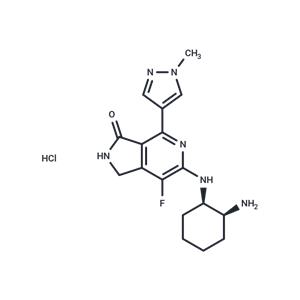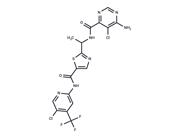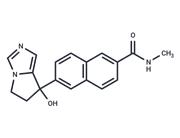| Name | TAK-659 hydrochloride |
| Description | TAK-659 hydrochloride (TAK-659) is a potent and selective inhibitor of spleen tyrosine kinase (SYK) with an IC50 value of 3.2 nM. It is selective against most other kinases, but potent toward both SYK and FLT3. |
| Cell Research | Cell lines: FLT3-dependent cell lines (MV4-11 and MOLM-13)Cells are maintained at 37°C in a humidified atmosphere containing 5-8% CO2. In a panel of hematological and solid tumor cell lines, inhibition of cell viability is determined using the soluble tetrazolium salt, MTS. Cells are seeded in 96-well tissue culture plates and are incubated at 37°C/5% CO2 for 24 hours prior to addition of compounds or DMSO vehicle. After 72 or 96 hours of incubation with compounds, MTS conversion by metabolically active cells is determined by measuring the OD490 nm of the wells using a Thermomax microplate reader. To generate concentration-response curves, cells are treated in duplicate with a range of serial compound dilutions. Prior to addition to cells, compound dilutions are prepared in DMSO. Equal amounts of DMSO are added to cells (final concentration is 0.5%). After background correction and normalization against DMSO-treated cells, EC50 values are calculated by curve-fitting these cell viability results using nonlinear regression analysis. |
| Kinase Assay | Kinases are prepared in Base Reaction Buffer (20 mM Hepes pH 7.5, 10 mM MgCl2, 1 mM EGTA, 0.02% Brij35, 0.02 mg/mL BSA, 0.1 mM Na3VO4, 2 mM DTT, 1% DMSO) and substrate is added with 1.5 mM CaCl2, 16 μg/mL Calmodulin, and 2 mM MnCl2. Varying concentrations of SAR-20347 in DMSO are added to the kinase reaction along with 10 μM 33P-ATP (activity 0.01 μCi/μL final) for IC50 determination[1]. |
| Animal Research | Animal Models: Athymic nude mice. Formulation: 0.5% carboxymethylcellulose (CMC). Dosages: 10,30,60 mg/kg QD. Administration: by oral gavage |
| In vitro | In a broad kinase panel, TAK-659 demonstrates a more than 50-fold selectivity for SYK and FLT-3 over 290 other protein kinases. Treatment with TAK-659 inhibits Syk activation and BCR signaling in co-cultured primary CLL cells and Burkitt's lymphoma cells. In primary CLL cells in suspension culture, TAK-659 treatment results in a dose-dependent reduction in the phosphorylation of SykTyr525, Btk, NFκB, ERK1/2 and STAT3 after BCR stimulation. Inhibition of Syk by TAK-659 induces apoptosis of CLL cells and abrogates BCR and co-culture-derived survival signals. TAK-659 inhibits chemotaxis toward BMSC, CXCL12 and CXCL13 in primary CLL cells, and abrogates microenvironment-induced chemoresistance. TAK-659 does not inhibit TCR signaling and molecular features of T cell activation in primary T cells from patients with CLL. In a cell proliferation assay, TAK-659 shows inhibition toward a SYK-dependent cell line (OCI-LY10). the sensitivity to TAK-659 is associated with mutations impacting SYK activity in B cell lymphomas, whereas TAK-659 is not cytotoxic for adherent primary or solid tumor cell lines. In cell viability assays, TAK-659 is shown to be sensitive toward FLT3-ITD dependent cell lines, MV4-11 and MOLM-13 while the WT FLT3 RS4-11 (ALL cell line) and RA1 (Burkitt's Lymphoma cell line) are not sensitive toward TAK-659. In cultured human tumor cells, TAK-659 potently inhibits the growth of hematopoietic-derived cell lines, with a concentration producing half-maximal response (EC50) ranging from 11 to 775 nM in sensitive cell systems (eg, diffuse large B-cell lymphoma, and AML). |
| In vivo | In the FLT3-dependent MV4-11 xenograft model, TAK-659 shows tumor regression at 60 mg/kg daily after 20 days of dosing. Preliminary plasma and urine PK data show that TAK-659 was absorbed quickly (median Tmax 2-3 hrs), with moderate variability in steady-state exposures (40-50% CV for DN-AUCtau), mean peak/trough ratio of 3.2–4.2, and mean accumulation of 2.1- to 2.6-fold after 15 d QD dosing. Renal clearance (CLr) of unchanged drug accounts for 30–34% of apparent oral clearance, suggesting a CLr contribution of ≥30–34% to TAK-659 systemic clearance. TAK-659 blocks anti-IgD (immune-globulin D antibody) stimulated CD86 expression in mouse peripheral B cells in vivo. |
| Storage | Powder: -20°C for 3 years | In solvent: -80°C for 1 year | Shipping with blue ice/Shipping at ambient temperature. |
| Solubility Information | DMSO : 1 mg/mL (2.63 mM), Sonication is recommended.
|
| Keywords | ZAP70 | VEGFR2 | TyrosineKinases | Tyrosine Kinases | TAK-659 Hydrochloride | TAK659 | TAK 659 | Syk | Spleen | JAK3 | Fms like tyrosine kinase 3 | fms | FLT3 | Cluster of differentiation antigen 135 | CLL | CD135 |
| Inhibitors Related | Ribociclib | Gilteritinib | Nintedanib | Regorafenib monohydrate | Sorafenib | Tofacitinib Citrate | ANTHRAQUINONE-2-CARBOXYLIC ACID | Regorafenib | Ruxolitinib phosphate | Gefitinib | Pazopanib | Axitinib |
| Related Compound Libraries | Failed Clinical Trials Compound Library | Bioactive Compound Library | Membrane Protein-targeted Compound Library | Kinase Inhibitor Library | Tyrosine Kinase Inhibitor Library | Anti-Cancer Clinical Compound Library | Drug Repurposing Compound Library | Inhibitor Library | Immunology/Inflammation Compound Library | Anti-Aging Compound Library | Bioactive Compounds Library Max | Anti-Cancer Active Compound Library |

 United States
United States






